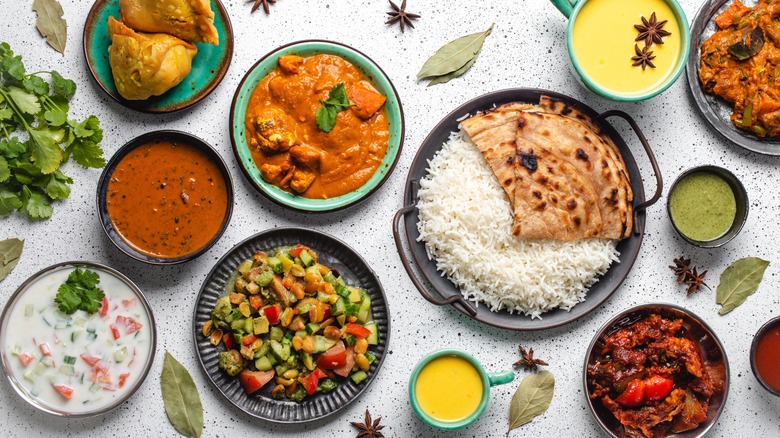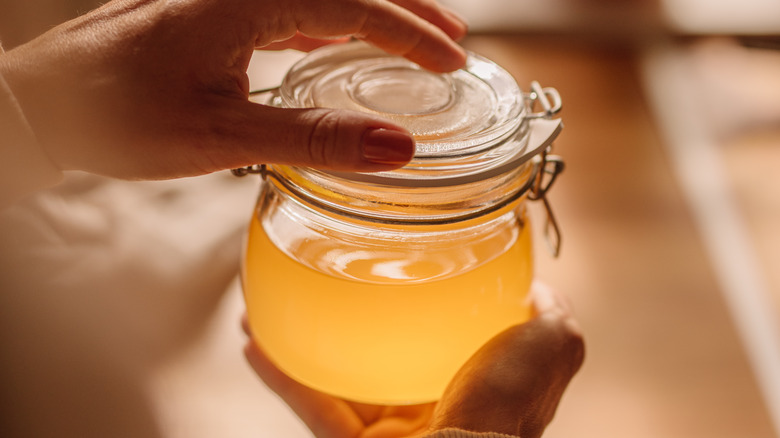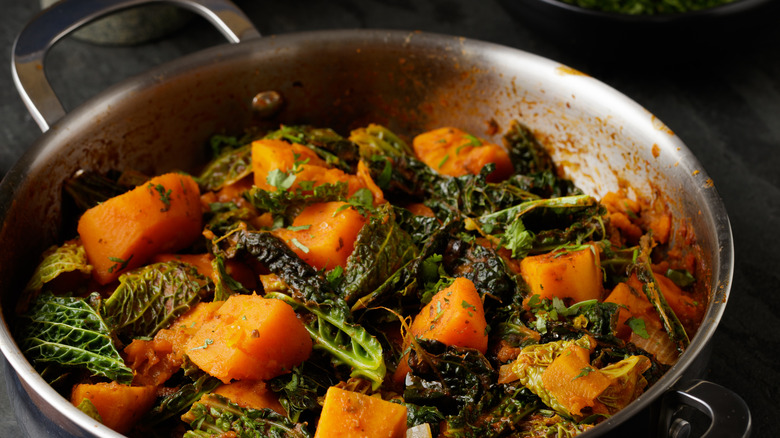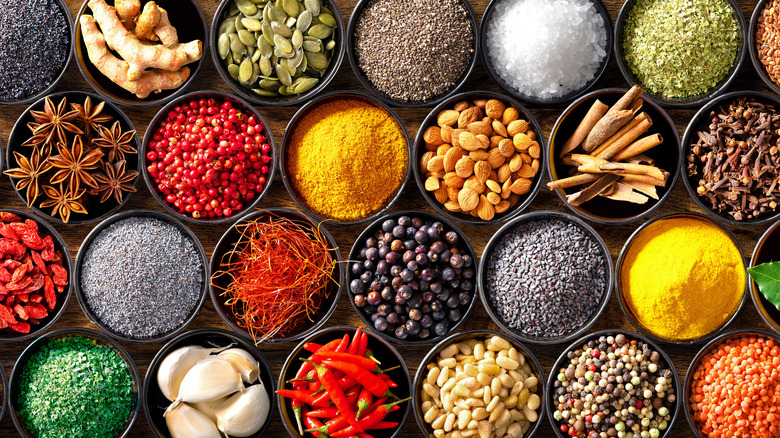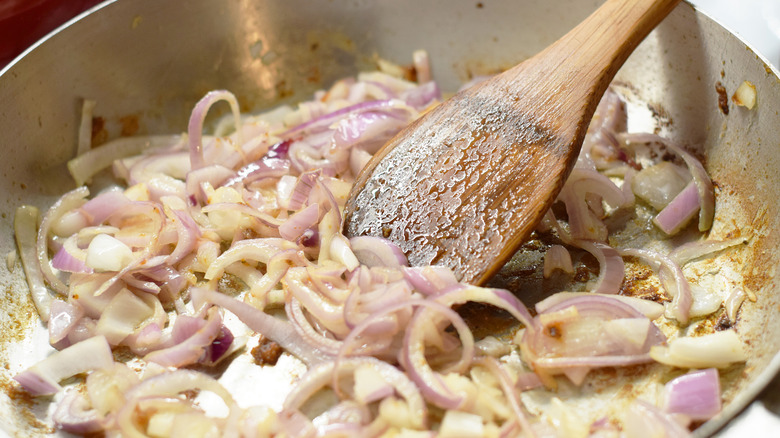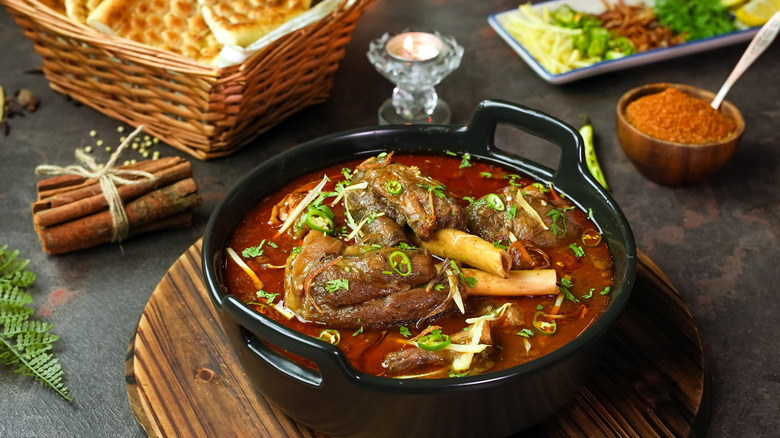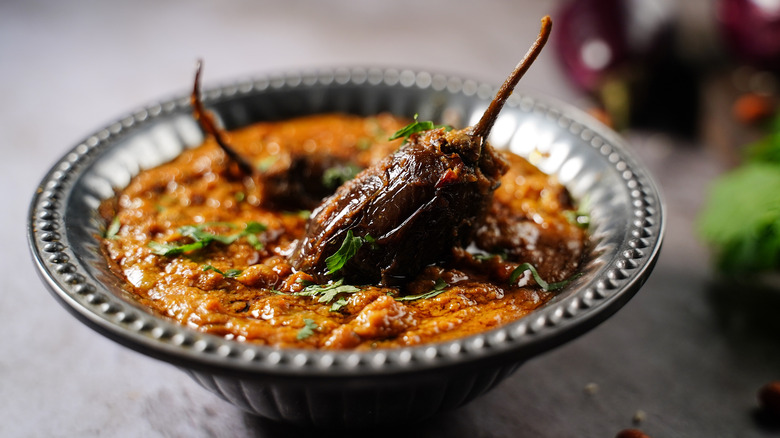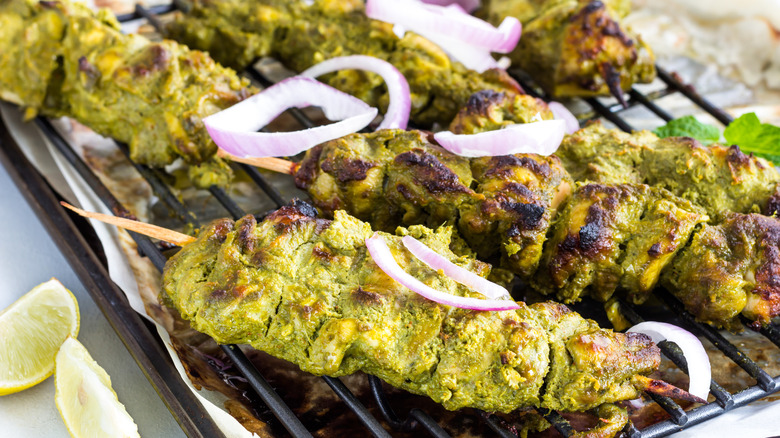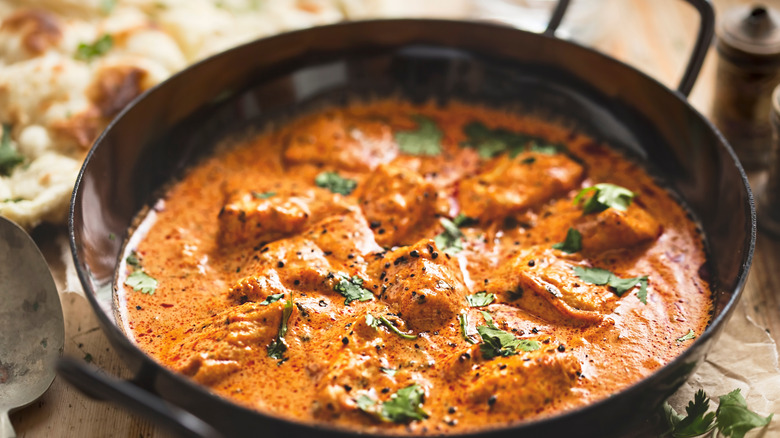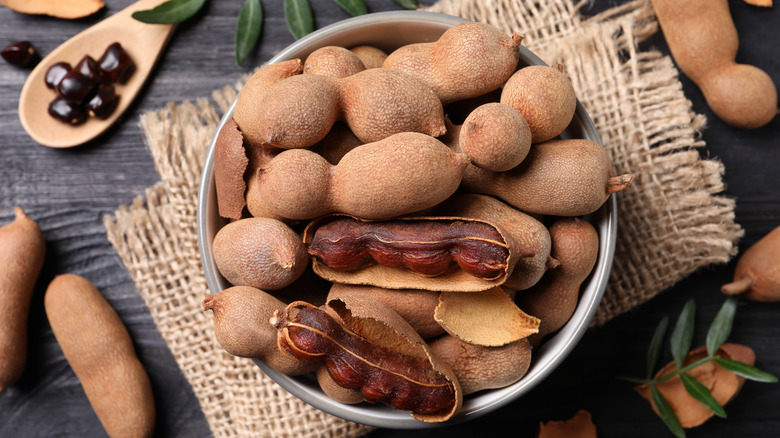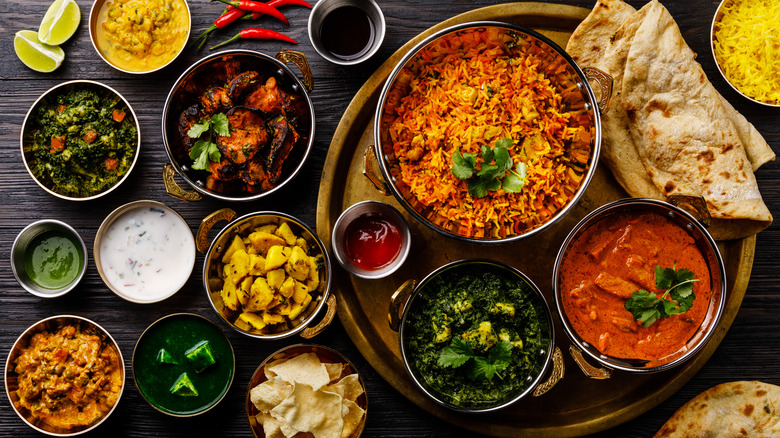12 Tips You Need To Make Restaurant-Quality Indian Curries At Home
Inexplicably, certain dishes taste much better when enjoyed at a restaurant. For most people, Indian food falls within this category. After all, there's nothing like sitting in a cozy restaurant, helping yourself to some poppadoms and chutneys, then mopping up a heavily layered, flavor-laden curry with soft buttery naan. For most people, achieving the standard of cooking you'll find at an Indian restaurant seems impossible. Isn't it true that numerous intricate ingredients, techniques, and specialized cookware are all required to recreate these curries at home? Well, not exactly — when broken down into manageable steps, it's an achievable goal for all home cooks, including beginners.
To help us all out, we're privileged to have an experienced expert from one of the U.K.'s premier Indian dining locations on board to give us tips. Executive Chef Arun Kumar works at Dishoom, a fast-growing restaurant group inspired by the Irani cafes in mid-century Mumbai (then called Bombay). Beloved for its authentic menu, atmospheric brand storytelling, elegant vintage interiors, and affordable yet inviting eats, Dishoom has locations in London, Manchester, Edinburgh, and Birmingham, alongside meal kits and a best-selling cookbook. The group has also committed to supporting charities in India and the U.K., offering a "meal for a meal," and has thus far donated over 15 million meals to hungry children.
But back to business — if you're interested in discovering cookery secrets from one of the most skilled cooks in the industry, let's dig in.
1. Choose the right fat to add flavor to your Indian curries
The starting point of most cooked recipes is fat. But which type of grease should you use when cooking Indian curries? Executive Chef at Dishoom, Arun Kumar, weighs in, suggesting that ghee, a sacred ingredient dating back to antiquity, is a great option. He notes that the golden liquid has abundant health benefits, including high levels of Omega-3 fatty acids (recognized for potentially benefiting heart health) and vitamin A (an essential micronutrient important in supporting immune function). When cooking with ghee, try to make the most of its high smoke point by adding it in moderate quantities to dishes that require cooking at high temperatures.
It's worth noting that specific Indian regional cuisines traditionally use oils that complement the local ingredients, enhance the rich spicing, and add subtle yet complex flavor to a dish. Consider pungent mustard oil for Bangladeshi curries, roasted peanut oil to round off spicy Maharashtrian cuisine, and fiercely nutty gingelly oil (toasted sesame) or coconut oil for South Indian feasts.
Alternatively, for a more neutral base that aids in carrying the complex spicing of Indian cuisine throughout the dish, Arun recommends using rapeseed oil, which is inexpensive, accessible, and unlike ghee, suitable for vegans. The neutral oil also boasts valuable health benefits, particularly vitamin E. Rapeseed oil is the top choice for the curries at Dishoom due to these reasons, and it is equally suitable for home cooks.
2. Invest in the right cookware for Indian food
An avid home cook knows the importance of good cookware. There's nothing more frustrating than food sticking to the pan when it's not supposed to, or spices reacting with the material and causing erosion. Choosing the proper cookware for Indian food is particularly crucial, due to the abundance of acidic ingredients and the high risk of burning spices if anything sticks.
Households across India will typically use a selection of specialist pans, the most common being a round-bottomed, high-sided pan similar to a wok, known as a kadai. The most common cookware materials are pure aluminum, stainless steel, or traditional clay. What you need to know about aluminum cookware is that while it offers superior thermal conductivity and is the most affordable, the metal can also react to acidic ingredients, leaving an unpleasant taste. According to Livestrong, it's also often touted as unsafe, although this isn't definitively proven. Clay cookware, on the other hand, is notoriously hard to maintain and risks cracking. The clear winner is stainless steel — indeed, Arun Kumar agrees, indicating it's the best choice for cooking curries at home. Still doubtful? Here's a tip for cooking with stainless steel: It can be seasoned, which helps prevent sticking, one of its otherwise frequent issues.
But what about non-stick cookware? It's arguably one of the most popular choices for home cooks, but Arun advises against it. Healthline states that non-stick cookware releases toxins at high temperatures, which Indian cookery often demands.
3. Stock up on some essential ground spices and whole spices
If you're interested in making Indian restaurant-caliber curries at home, one of the first steps worth taking is to ensure your spice racks are well stocked. Build your collection slowly but gradually. Start with a small supply of versatile spices that will allow for cooking myriads of popular Indian restaurant dishes, and if needed, slowly add more obscure seasonings to the mix. The collection should include an array of ground and whole spices, building up the complex layers of flavors for which Indian cuisine is renowned.
When we spoke to the experienced Executive Chef of Dishoom, Arun Kumar, he listed these ground spices as essential: turmeric, cumin powder, coriander seed powder, and red chili powder. The latter is notably different from blended chili powder intended for Mexican dishes — the Indian variety is made from ground red chili peppers and is often called "lal mirch." Whole spices to buy include cinnamon sticks, black peppercorns, green cardamom, and cumin seeds.
Recipes will also often include garam masala, a homemade blend of aromatic spices which is sprinkled over the dish at the end. You can buy this pre-made, or toast and grind the spices yourself for a fresher taste.
4. Use plenty of fresh aromatics
Aromatics — otherwise known as ingredients that add a depth of flavor and aroma to your food — are utilized in every cuisine. When thinking of Indian food, it's easy to attribute much of the flavor to dried spices. Contrary to this notion, to bring the complex layering of sweetness, piquancy, earthiness, and sourness present in Indian restaurant cooking to the kitchen, look beyond basic spices and include more aromatics.
Firstly, vegetables. Red onions, garlic, and ginger are each widely used in Indian curries. Onions are typically sliced, diced, or pureed, and when slow-cooked until caramelized, they contribute sweetness and robustness to a dish. Ginger and garlic are often made into a smooth paste and added near the beginning of cooking, adding pungency. However, Chef Arun Kumar cautions against excess, warning that it can cause bitterness if overused. Completing the trinity of fundamental aromatics are chili peppers. Fresh chili offers a different taste profile to its dried counterpart, providing a brighter, punchier heat. For the most authentic flavor, try to source "jwala" chilis, also known as finger chilis.
In addition to these foundational aromatics, consider including a dash of rose and kewra water for floral hints in royal, rich, and creamy curries. In contrast, fiery and drier curries can benefit from chopped coriander stems in the curry base, citrusy fresh curry leaves, and dried fenugreek leaves (kasuri methi) crushed over before serving.
5. Take your time to cook out the ingredients
Experience has taught Kumar many things: Perhaps the most important, he says, is that "cooking every ingredient — onion, ginger garlic paste — with time and love is key." He continues, expressing that one of the most common mistakes he sees holding home cooks back from making spectacular Indian curries is that they often rush through the cooking process. Doing so, he says, leaves the dish with "raw flavors." Usually, when you feel something is lacking in your curry, you likely haven't dedicated enough time to sweating down the onions or cooking the tomatoes until they reach that gorgeously thick, jammy consistency.
Knowing how long to cook each ingredient often boils down to experience. However, a good rule of thumb is to cook most ingredients slowly at low temperatures — spices, aromatics, tomatoes, and even meat all benefit from this treatment. As an exception to the rule, save fresh herbs until the last few minutes of cooking, so they retain their bright and zesty piquancy.
6. Avoid burning your spices by controlling the temperature
There's one fatal mistake guaranteed to ruin Indian curries. Picture this: You look away from the pan for a split second, and your spices have caught on the bottom and started to burn. What should you do? Unfortunately, if the spices burn, you cannot salvage the dish, as the overpoweringly bitter taste will ruin the entire curry.
To prevent this, it's essential to continually monitor the temperature of your pans and stovetop while cooking. Aim to keep the temperature at the lowest setting when adding the spices, and gently sauté, retaining a constant, watchful eye. If, despite your best efforts, this is a frequent reoccurrence, add a splash of water while frying them off; this should prevent the spices from catching. Alternatively, only add the ground spices after adding fresh tomatoes. Similarly to the previous method, the moisture from the tomatoes will keep the pan from going dry and sticking.
7. Choose bone-in meat for maximum flavor
You may have heard that Indian cuisine has a reputation for being vegan-friendly, and it's true that many dishes in home kitchens and restaurants alike are meat-free. However, for those of you who can't get enough meat, there's also a lot to love: succulent, tender pieces of lamb in an intensely hearty Rogan Josh sauce, the crowd pleasing chicken makhani (butter chicken), tantalizingly slow-cooked nihari, or village-style fiery chicken rassa, the options are endless.
Everyone has a preference on whether to cook with boneless or bone-in meat, but when it comes to restaurant-style Indian curries, there's an obvious winner. Most meat-based curries benefit from slow cooking, and as Chef Arun Kumar notes, the bone marrow offers irreplaceable depth to the body of a curry. Furthermore, the collagen in the bone marrow contributes to the sauce's thickening and delivers essential nutrients for the health of bones and joints. Besides, after simmering for a few hours in rich spices, the meat will be wonderfully juicy, ready to fall off the bone, and enticingly melt-in-the-mouth tender. So, opt for a whole chicken, beef shin, lamb shanks, or lamb chops straight from your local butcher.
8. Layer flavors throughout the dish for complexity
Perhaps the most renowned element of Indian curries — and the hardest to get right — is the sophistication of flavor achieved from layering spices throughout your dish. Generally, this process refers to adding certain ingredients at specific points in the cooking process, rather than dumping them into a pan all at once.
Indian curries begin by sweating whole spices in fat. If you skip straight to ground spices and don't incorporate these into your dishes, you're missing out; whole spices like seeds add unexpected bursts of flavor to each bite, while aromatics such as cinnamon and cardamon (discarded before eating) infuse the fat with heady fragrances and earthy nuance. The next layer is completed by caramelizing onions, ginger, and garlic, releasing a subtle sweetness from the savory vegetables. Next to be added to the pan are ground spices, which, unlike their whole counterparts, disperse their kick evenly throughout the dish, invigorating the body of the sauce with hearty, robust warmth.
Generally, this mixture is left to simmer for around 30 minutes, leaving the flavors to mellow and infuse. If you thought the layers were done being built, you'd be wrong; before serving, it's customary to incorporate garam masala, a freshly ground fragrant spice blend designed to infuse the curry with a delightful warmth and toasted nuttiness. Finally, fresh garnishes deliver a much-needed vitality of bright, crisp, ingredients. As you can see, despite the mysticism surrounding cooking Indian curries, building up layers is painstaking and methodical.
9. Marinate ingredients to infuse extra flavor
Some of the most popular plates in Indian restaurants feature marinated meats, cheeses, and vegetables. No, not just starters like hariyali paneer, chicken tikka, or lamb tandoori; it's also an essential technique in beloved dishes like butter chicken. The purpose of marinating ingredients is twofold. First, marination ingredients such as yogurt and lemon juice aid in tenderizing meat, thereby allowing more flavor to penetrate the tissue. The methodology works comparably with plant-based meats, tofu, paneer (Indian cheese), and even vegetables like potatoes, so there's no need to be limited by dietary preferences.
The second reason for marinating ingredients is to infuse a greater depth of flavor. In addition to yogurt, you will always find seasonings such as dried herbs and spices combined with oil, an excellent flavor carrier. After a few hours of marination — and grilling to get those beautifully charred edges and a delectably smokey flavor — even the blandest of ingredients can be utterly transformed.
How long should you marinate your ingredients? The answer to that question depends on a few factors. Plant-based foods and vegetables require less marinating time, as they don't need to tenderize. Likewise, smaller chunks of meat will require a much shorter duration than whole thighs or breasts. We recommend marinating your meat for less than 24 hours; red meat requires around 6 hours, while 15-30 minutes should be adequate for chicken, seafood, and vegetables.
10. Know how to cool down a curry that's too spicy
If you've ever tasted a curry and realized too late that you added too much chili powder, chances are you thought it was too late to rescue the dish. Although most of us would prefer never to make blunders while cooking, it's just not realistic — so, learning to adapt to and rectify mistakes is vital to creating restaurant-standard dishes. Taste your food as you cook, so you can adjust the seasoning while cooking rather than at the table.
One of the most prevalent myths about Indian food is that all the dishes are spicy. While that punchy, fiery kick is a characteristic of some Indian dishes, others have a delicate, creamy, decadent flavor that allows the natural earthiness of other aromatic spices to sing. It's easy to transform a curry that's too hot into a milder, silkier affair. How? Just add dairy: cream, coconut milk, or yogurt, depending on the dish. South Indian curries pair beautifully with coconut milk, while North Indian dishes are best with cream or yogurt stirred through. To avoid splitting, add the dairy over low heat and stir continuously. Bear in mind that adding dairy will thicken your sauce, so you'll need to adjust accordingly.
11. Balance the curry by utilizing all five basic taste groups
For many years, scientists assumed there were four taste groups: sweet, salty, sour, and bitter. In the early 1900s, umami — a hard-to-describe savoriness — was added to the list. Together, these tastes build the perception of flavor and have the potential to elevate meals to new heights. Often, home cooks neglect one or more of these groups, resulting in an unbalanced curry. The disparity can be barely perceptible, but once it's corrected, you'll easily be able to taste the difference in depth and complexity. Learning how to balance flavors by counteracting tastes can also work in your favor with correcting mistakes.
To add sweetness to a curry, grate a little jaggery (caramel-like cane sugar) or sprinkle over a pinch of sugar, and allow it to cook out. Salt helps to carry flavors and enhance the taste of other vegetables, meats, and spices in your dish. Sourness is an essential component of most recipes as it complements fiery heat perfectly; traditionally, cooks utilize a squeeze of fresh lemon juice, fruity kokum, tamarind paste, or dried pomegranate powder. In a pinch, you can use vinegar. Bitterness often comes naturally from spices — in particular, turmeric powder and mustard seeds provide subtle bitterness.
The final element, umami, is more elusive. The best way to incorporate it into Indian food is by using tomatoes, a vegetable rich in high glutamic acid (the compound responsible for umami), or by including meat and seafood in your dishes.
12. Don't forget to add garnishes at the end
You've cooked the curry, prepared the side dishes, and set the table. There's only one thing remaining, and it's often the difference between a hastily prepared home-cooked dish and a restaurant-quality showstopper: garnishes. Adding fresh herbs and raw aromatics is another mode of building depth, elevating the plate, and offering pops of vibrant flavor across each bite.
One of the most unique forms of garnishing Indian food lies in a method that adds new depths of flavor to spices. Tadka (tempering) involves heating aromatics — such as dried red chilis, curry leaves, and even lentils, although this is entirely customizable — in hot oil until they crackle and splutter. When poured on top of a freshly made curry, it adds a fresh explosion of flavors and aromas.
For more traditional garnishes, the chefs at Dishoom often finish plates with bursts of tart pomegranate arils. The scattering of deep-red seeds offers a welcome juiciness, a slight bite, and a surprising mix of sour and sweet notes. Moreover, in our conversation with Arun Kumar, he mentioned favoring sharp julienned ginger, cooling freshly torn mint, finely sliced green onions, and a spice you can't skip when cooking Indian food: fresh cilantro (coriander). Lastly, don't forget to use slivered nuts and a drizzle of cream over curries with sweet, mild, and aromatic notes.
Static Media owns and operates Tasting Table and Mashed.
